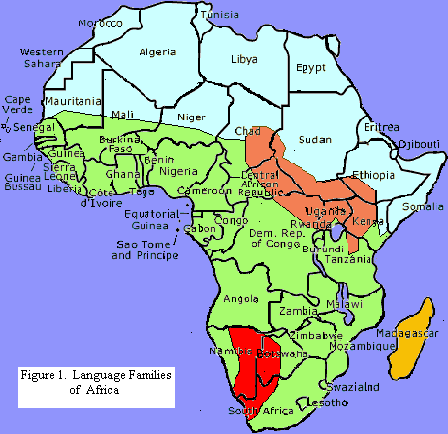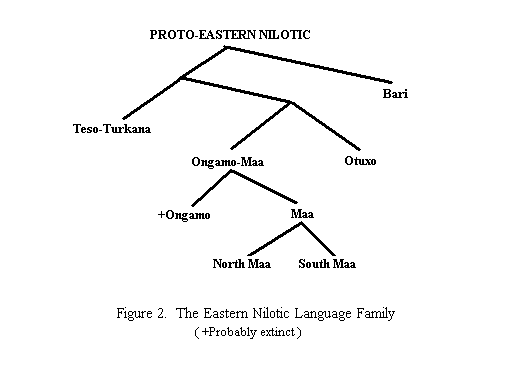2. The Nilo-Saharan Language
Family
(The Maa Language and its Historical Connections)
2.1 Language Families of the African Continent
Linguists and anthropologists agree that, prior
to the colonial era, the African continent was peopled by speakers from
four major language families. This was argued most clearly by linguist
Joseph Greenberg in the late 1950's, as he examined data collected by numerous
scholars and explorers from the 18th, 19th and 20th centuries (Greenberg
1963). Just as there is no known linguistic connection between Afro-Asiatic
and Indo-European, so there are no known linguistic connections between
these four families.
 Afro-Asiatic is
found across the northern part of the continent (and also extends into
the Middle East).
Afro-Asiatic is
found across the northern part of the continent (and also extends into
the Middle East).
 Niger-Congo spreads from the western part of
the continent (where the "parent" language called Proto-Niger-Congo
was likely centered), across the central and to the southern parts of the
continent.
Niger-Congo spreads from the western part of
the continent (where the "parent" language called Proto-Niger-Congo
was likely centered), across the central and to the southern parts of the
continent.
 Khoisan is localized in the south, though it
previously extended much farther east across the continent (and even now
one or two languages are found as far north as Tanzania).
Khoisan is localized in the south, though it
previously extended much farther east across the continent (and even now
one or two languages are found as far north as Tanzania).
 Nilo-Saharan extends along the southern reaches of
the Nile River, along the Great Rift Valley, as far south as modern Tanzania,
and westward into Congo (formerly Zaire).
In addition, the
Nilo-Saharan extends along the southern reaches of
the Nile River, along the Great Rift Valley, as far south as modern Tanzania,
and westward into Congo (formerly Zaire).
In addition, the  Austronesian language Malagasy
is spoken on the island of Madagasgar.
Austronesian language Malagasy
is spoken on the island of Madagasgar.

The approximate modern locations of the four original
language families, across the continent of Africa, are indicated by color
in Figure 1. Since the colonial era, European languages like French,
Portuguese, Spanish, German, English, and Afrikaans are also found on the
African continent.
2.2 The Maa Language within the Nilo-Saharan Family
Within Nilo-Sarahan is found the Nilotic sub-family.
(The relationship between Nilo-Saharan and Nilotic might be roughly comparable
to the relationship between Indo-European and West Germanic; the latter
being comprised of English, Frisian, Flemish, Dutch and Afrikaans.)
It is within the Nilotic family that we ultimately locate the Maa language.
Linguist Rainer Vossen distinguishes three sub-branches
within the Nilotic family. These have been designated "Southern," "Western,"
and "Eastern." (The labels refer to linguistic groupings, and not primarily
to geographical distribution.) Some Western Nilotic languages include
Shilluk, Acholi, Dinka, Dholuo and Lango. Some Southern Nilotic languages
include Datoga, Pakot, Endo, Saboat, and Nandi. (The term "Kalenjin" is
commonly applied to some of these languages, though this term is more political
or geographical, than linguistic.) Vossen, Heine, Dimendaal, and others
have suggested that Eastern Nilotic contains the languages in Figure 2,
in the indicated groupings.

As seen in Figure 2, the
Maa language has internal sub-divisions. At this level, the sub-divisions
are referred to as dialects, because while Maa speakers themselves are
aware of, and react to, the differences as marking speakers from different
houses (very large clan groupings) or areas, the speech varieties are mutually
intelligible. North Maa is said to include the speech varieties of the
IlSampur and IlCamus houses. South Maa is said to include the varieties
spoken by the IlArusa, IlMoitanik, Isiria, IlWuasinkishu, IlPurko, IlKeekonyokie,
IlDamat, IlOitai, Isikirari, IlOodokilani, IlDalalekutuk, IlDamat, IlKaputiei,
IlMatapato, IlKisonko, and perhaps others (Vossen 1988). Linguistically,
some of these are extremely close, though even within these subdivisions
the lexicon of speakers from one village to another may vary slightly.
There are other subdialects of South Maa that do not necessarily
correspond to Maa ethnic distinctions, as is the case of Mukojodo Maa.
In this description we cannot explore differences between the dialects
in much detail, other than to note that there are differences, ranging
from pronunciation, to lexical items, to various syntactic rules. In conjunction
with the Maasai Cultural Center, a dictionary project is underway which
will include lexical information about dialect variation.
In the remainder of this description we look at some
major facets of the Maa language, which make it "be" Maa, as opposed to,
say, Swahili, Luo or English. Numerous scholars have studied the Maa language,
but the classic linguistic foundation remains the work of Archibald N.
Tucker and John Tompo Ole Mpaayei, A Maasai Grammar with Vocabulary,
published in 1955 by Longmans, Green and Company of London.
Back to top
Back
to The Maasai Language
This page written by Doris L. Payne.
Last updated August 2008.
Afro-Asiatic is found across the northern part of the continent (and also extends into the Middle East).
Niger-Congo spreads from the western part of the continent (where the "parent" language called Proto-Niger-Congo was likely centered), across the central and to the southern parts of the continent.
Khoisan is localized in the south, though it previously extended much farther east across the continent (and even now one or two languages are found as far north as Tanzania).
Nilo-Saharan extends along the southern reaches of the Nile River, along the Great Rift Valley, as far south as modern Tanzania, and westward into Congo (formerly Zaire).
Austronesian language Malagasy is spoken on the island of Madagasgar.

